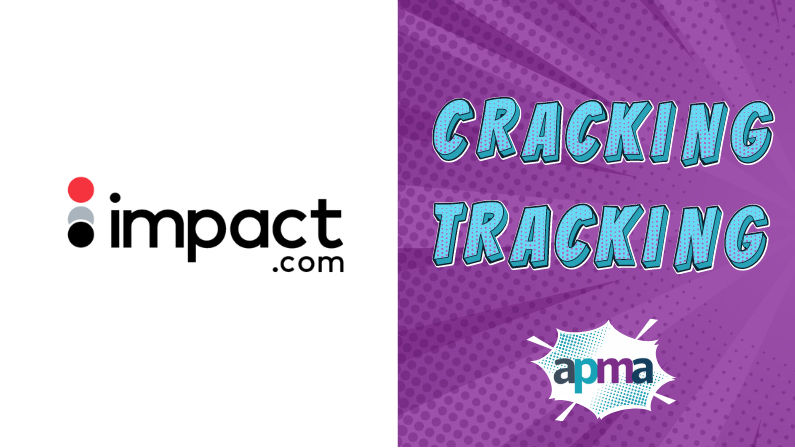
We spoke to impact.com’s James Bennie, Area Vice President, for our Cracking Tracking: Network Q&A.
In one sentence, what makes your tracking so good?
Our tracking works consistently across web and mobile app platforms without any need for third-party cookies — via simple ecommerce integrations, a reliable JavaScript tag, or flexible API connections.
Now explain to me how it works as if I’m a five-year-old…
Susie reads a story about some new clothes and decides she wants to buy them. When she clicks a link in that story, our system writes a little note that says “User 123 clicked on that partner’s link.” It’s important to respect Susie’s privacy, so we come up with a secret code instead of actually putting her name in the note. Later, when Susie buys some clothes, our system looks at that note and remembers that “User 123” is the same person who just bought something. That way, we can tell the clothing company that the partner helped Susie find them, and that they should give the partner some money to say “thank you.”
How are we going to get rid of third-party cookies from the affiliate channel once and for all?
This change has already happened — anyone relying on third-party cookies in 2024 is already missing out on a huge percentage of conversions that occur in Safari. If a brand is not sure whether their affiliate or partnerships platform relies on third-party cookies, they should have that conversation immediately. The real question now is “How can we stop worrying about browser policies affecting our tracking?” The answer to that question is server-to-server tracking, or APIs. As long as crucial data is stored in the user’s browser, there will always be some danger that a new browser policy will make it harder to connect a click to a conversion. Server-to-server tracking cuts out the browser middleman and sends all the necessary data directly to the tracking platform’s server on click. Later, the conversion data is sent to the tracking platform as well, and the platform can attribute the conversion to the earlier click, without relying on any data stored in the user’s browser.
What should best-in-class tracking do?
Best-in-class tracking should capture each interaction between the user and the partner, so that the brand can get a complete view of the conversion path — including not only clicks and conversions, but also app installs, form submissions, subscription upgrades, and every other meaningful event. Besides accomplishing all that, best-in-class tracking should be reliable, simple to set up, and adaptable to any use case — and it should not be vulnerable to new browser policies like cookie deprecation.
Tell us some of the work you’re doing to push its adoption.
As a partnerships platform, our role is to offer tracking methods that provide the best attribution rates for all brands and partners, regardless of their technical resources. We are continually improving our Universal Tracking Tag (UTT), as well as streamlining our plug-and-play integrations with integration partners like Shopify, Magento, BigCommerce, and HubSpot. Right now, we’re working on some new tools to that will allow brands to proactively identify any gaps in their tracking setup and provide them concrete steps to increase tracking consistency when needed. This will also provide an extra level of transparency, so that publishers can see which of their brand partners are set up for maximum tracking efficacy. We’re also rolling out a feature that will ensure tracking for loyalty and cashback publishers in regions where GDPR applies, even when users have not specifically opted in to be tracked. Since loyalty rewards can only function when tracking works, users who attempt to redeem these offers are considered to provide implicit consent. Our new feature will provide more consistent attribution in these scenarios.
App tracking tends to get overlooked. What are you doing to make sure it doesn’t?
If a brand allows users to convert in their app, but is not tracking in-app conversions in their partnership program, they are massively undervaluing their program. Way back in 2019, we released TrueLink™ to provide in-app deep linking and mobile measurement. Since then, we’ve built that mobile focus into our DNA and we’ve worked with all the major mobile measurement providers (MMPs) and Customer Data Platforms (CDPs) to integrate their solutions as well. Each time we onboard a new brand, we work with them to learn how their users interact with their app and we ensure that they are set up to track every meaningful in-app event or app install, either through our own native solution or their MMP or CDP of choice.
There’s so much confusion about tracking because every network uses different terms. Is it essentially all the same?
At the core, all tracking is essentially doing the same thing. But there are many ways to accomplish that tracking — some better than others — and that’s led to much of the confusion. At impact.com, we’re committed to supporting our clients every step of the way, helping them navigate through the complexities and ensuring they fully understand and benefit from our tracking solutions.
What does the future of affiliate tracking look like?
In the future, affiliate tracking will:
1. All take place in a server-to-server context, which means that no one will need to wonder whether Apple or Google’s latest update will affect their tracking;
2. Follow Privacy by Design principles, which means that it will collect the data needed to attribute conversions and inform marketing decisions without compromising the user’s privacy; and
3. Be simple to integrate, thanks to one-click plugins and streamlined onboarding flows.
At impact.com, we’re committed to pushing the industry forward in these areas.
Thank you to James, if you have any questions or would like to get in touch, please email him.


